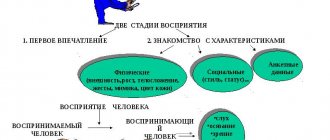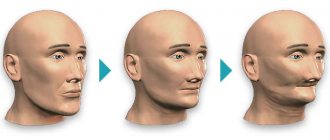A stuck personality type is an interesting character accentuation that contains both positive and negative traits. The quality of human life depends on their correct implementation. To do this, the “stuck” individual needs to carry out considerable psycho-correctional work on himself.
Mistrust is one of the main features
German psychiatrist classification
Leonhard determined types of character in psychology by assessing a person’s communication style with the people around him. At the same time, he developed and presented independent types of characters.
- Hyperthymic type. Such people are distinguished by their talkativeness, extreme contact, expressiveness of facial expressions and gestures. A person may regularly deviate from the original topic of conversation in communication; he may constantly have occasional conflicts with people around him due to the fact that he is too frivolous about family and work responsibilities. As a rule, such people themselves become initiators of conflicts. At the same time, they have many positive features that attract partners for communication. This is a thirst for activity, energy, initiative, optimism. Repulsive traits include a tendency to immoral acts, frivolity, and increased irritability.
- Dysthymic type. The person is taciturn, uncommunicative, pessimistic about the surrounding reality, and leads the most secluded lifestyle. At the same time, he values his friends highly and is ready to obey them.
- Cycloid type. He is characterized by regular mood swings, which changes the way he communicates with people around him.
- Excitable type. Such a person is characterized by low contact in communication, slow nonverbal and verbal reactions. Such people are prone to abuse and rudeness, are gloomy and boring, and constantly provoke conflicts.
- Stuck type. These are moderately sociable people, prone to moralizing, and very taciturn. In any business they strive to achieve maximum performance and place increased demands on themselves. Vulnerable and touchy, sensitive to social justice.
- Pedantic type. They practically do not enter into conflicts and generally behave passively. At work they make many claims and demands on others, and behave like bureaucrats.
- Anxious type. People from this group are characterized by timidity and low communication skills. They are predominantly in a depressed mood and feel insecure. They rarely enter into conflicts with others and play an extremely passive role in them.
- Emotive type. Such people prefer to communicate exclusively among a select few. They carry grievances deep within themselves. People around them are attracted by compassion, kindness, and have a heightened sense of duty. At the same time, they are very tearful and sensitive.
- Demonstrative type. These people easily establish contacts with complete strangers, love to be praised, and strive for leadership and power. Demonstrating high adaptability, they are prone to intrigue. At the same time, they irritate those around them with their own self-confidence, boasting, and hypocrisy. They are attracted by their exceptional artistry, courtesy, extraordinary actions and thinking, and are able to captivate others with some idea.
- Exalted type. Amorous and talkative people. They argue constantly, but rarely lead to conflict. They are attentive to friends, altruistic, ready to sympathize and show sincerity. They are repelled by susceptibility to momentary moods and alarmism.
- Extroverted type. These are contact people with a lot of friends and acquaintances. They always have many acquaintances and close friends, they are open to communication and any information. They attract others with their diligence and willingness to listen to another person. Many do not like him because of their frivolity, passion for entertainment, rash actions, and regularly participate in the spread of rumors.
- Introverted type. These are closed people, divorced from reality. They love to be alone. They have strong beliefs about life around them and strict principles. At the same time, they are ready to persistently defend their ideals, even if they are fundamentally wrong and stubborn.
It is worth emphasizing that this classification applies mainly to adults.
Pedantic character
If Leonhard’s character accentuation test showed that a person belongs to the “pedantic” type, then you have a character who notices every little thing and clings to it: in his work he may not finish what he started, because he is drowning in “subtleties” and continues to delve into in them to the last; in everyday life, he can scold for an item that is not on “his” shelf, but on the next one; In the words spoken, everything is important to the pedant - the placement of stress, intonation, and facial expression. It is precisely this scrupulousness that over time can cause emotional fatigue in a pedant, because his habit of observing all formalities and working on every detail requires enormous strength and concentration.
Excitable type
They are characterized by increased impulsiveness, low control of their own desires and inclinations, which are often led. Uncontrollable during violent emotional reactions.
They often show irritability and intolerance towards their surroundings and cannot tolerate criticism.
To people with this accentuation, study and work seem neither fun nor attractive. They usually do not set long-term and difficult-to-achieve goals and live in the present.
It is difficult for them to get along in a team due to frequent conflicts. During them, they may show inappropriate emotional reactions, react violently and spend a long time sorting things out.
Video
Tool for combing the hair of cats and dogs My Rules (deshedder, comb, slicker) size M
711 ₽ More details
History of Russia for children. Book Butromeev V.P. | Butromeev Vladimir Petrovich
888 ₽ More details
Nipple drinkers for rabbits
Types of accentuations
Types of temperament and character accentuation according to Leonard are divided into separate groups.
Temperament
The scientist attributed six types of accentuations to temperament, as a biologically determined formation. Let's talk briefly about each of them.
- Hyperthymic (hypomanic) temperament. Characterized by a predominance of an optimistic mood, a thirst for activity, a focus on success, and sociability. Negativity develops superficiality, an inability to complete a task. There is a violation of ethical standards, a waste of opportunities.
- Dysthymic type (subdepressive). The opposite of hyperthymic. Characterized by an orientation toward failure, pessimism, a serious ethical position, extreme passivity in action, and lethargy.
- Affectively labile type (cyclomic). It is characterized by frequent changes in hyperthymic and dysthymic states.
- Anxious. Characterized by the inability to defend one's point of view in a dispute, fearfulness, timidity, wariness, humility, and a humiliated position. Compensation in the form of feigned self-confidence or even impudent behavior is possible.
- The affectively-exalted type is distinguished by the intensity of experiences, violent emotional reactions, and a tendency to extreme manifestations of feelings (enthusiasm, despair). Easily charged by the mood of others.
- The emotive type is characterized by the ability to deeply feel and empathize. He is distinguished by his impressionability, kindness, and compassion.
From the editor: Development of intelligence in children and adults
Character
Leonhard's character classification is represented by four types.
- Demonstrative (hysterical) type. The peculiarity of accentuation is the hypertrophied tendency to repression. This explains the ability of the hysteric to embellish reality. A person, as it were, enters into the desired image, beginning to believe his fantasies. Thanks to this trait, he easily adapts to his environment, instilling in himself a feeling of love and sympathy for others. The notorious “need for recognition,” as one of the motives of the demonstrative type, is exaggerated. Rather, the passion for self-praise is associated with the ability to repress objective information about oneself. For an ordinary person, if he wants to embellish the real state of things, the brakes are turned on. A hysteric person tends to forget himself, which often leads to rash actions.
- Pedantic character. In contrast to the demonstrative type, the repression mechanism is poorly developed. People with this type of personality are not able to repress doubts or discard unimportant details of the issue, so they can hardly make their choice on any decision. Hence indecision, scrupulousness in work, hypochondria.
- Stuck type. Characterized by the persistence of affective reactions. A penchant for ideas that completely take over a person’s thinking. Stuck affect is most clearly manifested in the case when a person’s personal interests are affected. Affect in these cases turns out to be a response to wounded pride, as well as to various forms of suppression, although objectively the moral damage may be negligible. As a result, the stuck type develops such traits as suspicion, hostility, jealousy, and morbid ambition.
- Excitable type (epileptoid). Characterized by following lower instinctive impulses and ignoring the voice of reason. As a result, impulsiveness, incontinence, demandingness, intolerance, hot temper, and conflict develop.
Extroversion/introversion
Character types according to Leonhard also include extroverted and introverted personality accentuations.
Due to the fact that most psychologists rely on the interpretation of terms according to Eysenck, and psychiatrists - according to Leonhard, such terminological discrepancy creates a problem in finding a common language between specialists.
According to Leonhard, the extroverted personality type is a conformist who does not subject to special analysis information coming from the outside, and therefore easily succumbs to the influence of others. An introvert, on the other hand, does not blindly succumb to the sensations of the present moment, focusing primarily on previous life experiences and his own conclusions. Here, Leonhard’s opinion coincides with the point of view of Carl Jung, who attributed to introverts the traits of thinking types, and to extroverts - ethical (experiencing) types.
Personality diagnostic methods
Leonhard considered observation and conversation to be the most reliable diagnostic methods
During a personal conversation, the scientist should not study verbal information coming from the patient, but focus on his facial expressions and changes in voice intonation. Studying the patient’s behavior at work, in a relaxed home environment, and in communication with other people, according to Leonhard, provides comprehensive information about the characteristics of his personality
However, it is not always possible to carefully monitor patients even in a hospital setting. In this case, working with G. Šmishek’s questionnaire will come to the rescue.
The text of the questionnaire, the key for processing answers, a detailed description of individual scales and combinations can be found in the book by Yu.V. Kortneva “Diagnostics of a current problem. Leonhard-Smishek technique."
As a person grows up and his personality develops, bright accentuated features smooth out. By adapting to the demands of the social environment, the individual learns to control his natural temperament. As a rule, Leonhard’s character typology is used when working with teenagers whose character has not yet been completely established.
https://youtube.com/watch?v=cVDzF7AuhD4
Hyperthymic and cycloid
The hyperthymic type is characteristic of people who are poor strategists, but brilliant tacticians. They are enterprising, resourceful, active, and easily navigate changing circumstances. Due to this, they can significantly improve their social and professional position and move up the career ladder. But at a certain moment they tend to lose their position due to their inability to calculate certain actions in advance; they often make mistakes in people.
People with the hyperthymic type are sociable, active, enterprising, they are always in a good mood, at least in public. Children are restless, active, often play around and play pranks. Teenagers study unstably and have poor discipline. Because of this, conflicts arise with representatives of the older generation. They always have a lot of superficial hobbies, none of which really interests them. In life, they constantly overestimate their capabilities.
Cycloid accentuation is characteristic of apathetic and irritable people. As children, they constantly want to be left alone and do not like to play with their peers. They take any troubles very hard, and in response to any comments they become very irritated, even if they are the most harmless. Adolescents with cycloid accentuation experience dramatic mood changes.
In adulthood, the sharpest edges are smoothed out, but some can get stuck on their complexes, turning into melancholic and depressed individuals. Often their mood depends on the time of year.
Personal level
Additionally, the typology distinguishes 2 types of personality accentuation – extroverted and introverted. Their interpretation by Leonhard does not coincide with the interpretation by other scientists (Eysenck).
Extroverts easily fall under the influence of others and change their minds. They easily adapt to changed circumstances, successfully communicate with new acquaintances, and effectively master new information.
Introverts tend to draw on their own experiences. They are so immersed in their inner world that they are detached from reality and are not influenced by life circumstances. They tend to reason and philosophize more than to act. This type of personality does not allow interference in their life and defends their own views and principles. K. Leonhard considers introverts to be more strong-willed individuals.
Concept
The concept of “accented personality” was introduced by the German psychiatrist and psychopathologist Karl Leonhard. His classification of personalities had much in common with the concept of “latent psychopathy,” previously proposed by the Soviet scientist Pyotr Gannushkin. However, it was developed by Leonhard into an independent theory.
From the editor: Causes, symptoms and treatment of periventricular leukemia?comalacia
The scientist presented his thoughts on character typology in his work “Accented Personalities.” The first part of the monograph provides a classification and analysis of various accentuations; in the second, accentuated types are examined using the example of heroes from classical works of world literature.
At first glance, character accentuations according to Leonhard are similar to personality disorders, which leads to the assumption that there is a connection between them. However, the scientist only sought to identify those personality traits that bring difficulties to their owners in life. When describing accentuations, Leonhard turned to the negative manifestations of certain character traits in an extreme, most pronounced form. Therefore, his characterization of psychological types is perceived as an illustration of human shortcomings and painful patterns of behavior. However, accentuations according to Leonhard are still a manifestation of the clinical norm, albeit in a more acute form, and therefore cannot be used as a psychiatric diagnosis.
Psychologists and psychotherapists around the world are actively interested in issues of accentuation, since the disproportionate development of certain personality traits creates conditions for the formation of corresponding mental or psychosomatic disorders.
In Russian psychology, Leonhard’s typology was developed and supplemented by the scientist Andrei Lichko, who changed the original term “accentuated personality” to “accentuation of character.” After all, an accentuated personality, according to the Soviet psychiatrist, is too complex a concept, more consistent with the idea of psychopathy.
Correspondence table of accentuations according to Leonhard and Lichko.
| No. | K. Leongard (questionnaire by H. Smishek) | A.E.Lichko (PDO questionnaire) |
| 1. | – | Astheno-neurotic |
| 2. | Dysthymic | – |
| 3. | Demonstrative | Hysterical |
| 4. | – | Unstable |
| 5. | Stuck | – |
| 6. | Pedantic | Psychasthenic |
| 7. | – | Schizoid |
| 8. | Hyperthymic | Hyperthymic |
| 9. | – | – |
| 10. | Excitable | Epileptoid |
| 11. | Anxious-fearful | Sensitive |
| 12. | Cyclothymic | Cycloid |
| 13. | Affectively exalted | Labile hysteroid |
| 14. | Emotive | Labile |
| 15. | – | Conformal |
| Total | 10 | 12 |
Cyclothymic character
“Cyclothymic” character is cyclical and changeable. Such people change their moods several times a day without good reason. Periods when they strive towards their goals with manic persistence are followed by days of complete powerlessness, inertia and depression. “Cyclothymic” characters tend to go to extremes in everything and do not know how to stick to the “golden” mean.
Thus, determining the personality type according to Leonhard helps psychologists and psychiatrists understand the nature of neuroses and mental disorders of their patients. Further actions of specialists will be aimed at smoothing out pronounced character traits and finding a balance that will ensure a person’s mental health.
Typology according to Leonard
The scientist identified 10 accentuated types:
Demonstrative. This is a self-confident and vain individual, for whom his own personality is of greatest value. The people around you are not interested. In order to impress, he is ready to resort to flattery, lies and boasting.
Emotive. A weak personality, distinguished by kindness and compassion for others. Due to excessive fearfulness and sensitivity, an individual often does not risk taking responsibility, making decisions, or refusing someone’s request. Emotions and feelings come first for him. Hyperthymic. The hyperthymic type of accentuation is characteristic of success-oriented people. They strive to be active and achieve the desired results. They are distinguished by optimism, a positive outlook on life, and faith in luck. For such people, new emotions and experiences that bring pleasure are of great importance.
Dysthymic. This is the complete opposite of the previous character. The dysthymic type of accentuation is otherwise called hypothymic. Such people are always serious and initially focused on failure. They are often depressed. When starting a new business or finding yourself in unfamiliar circumstances, they experience anxiety and apprehension. Behavior is somewhat retarded.
Labile. Characterized by extreme mood swings. A person switches with lightning speed from one emotional experience to another. Labile psyche is characterized by increased sensitivity to signs of attention. The individual is oriented towards various standards, the loss of closeness with which becomes a real test.
Anxious. There is excessive suspiciousness and concern. A person is constantly afraid that something bad might happen. When communicating with others, he is timid and shy. Any failure is experienced very acutely. In the future, the fear of making a similar mistake again is formed.
Exalted. Emotions are elevated to a cult. Such individuals experience real jubilation from ordinary positive events or become depressed due to minor problems. Any emotion in this type is expressed much more clearly than in any other. An exalted (or affectively exalted) type of character is often characteristic of representatives of creative professions, who are distinguished by amorousness, sociability, and impressionability. All this is manifested in active gestures, rich facial expressions, rapid actions, etc.
Pedantic. Great importance is attached to preliminary consideration of actions and situations. Excessive indecisiveness leads to an overly responsible approach to any problems, both in personal and professional life. Any changes in usual circumstances are a source of stress due to increased rigidity of thinking.
Stuck. Individuals with a similar mental feature can be “stuck” in one negative emotional state for a long time. The impact is especially serious in situations where their personal feelings are hurt. Such people never forget the insults inflicted on them, so they often enter into conflicts.
Excitable. The main feature is hot temper. It is difficult for a person to control his own thoughts and behavior. If he is in a state of excitement, he is unable to control himself
In behavior, rationality gives way to instinctiveness: no rational arguments are taken into account due to the desire to release emotions or satisfy a momentary need.
Additional two types relate to the personal level: extroverted (focus on the surrounding reality, active interaction with it), introverted (the main attention is paid to one’s internal state, and the external environment is ignored as much as possible)
Editor's Note: Ask an Expert
Causes
How to love yourself - what does this mean in psychology, acceptance of your personality
The exact reasons that cause the development of psychopathology are not known. There are several views describing the process of its emergence. According to the first theory, the formation of a stuck character of the paranoid type is a genetic predisposition.
Additional Information. Scientists have found that twins exhibit paranoid traits to almost the same extent. This suggests a hereditary predisposition to the paranoid type.
Quite often, the stuck type of accentuation occurs in those people whose close relatives suffered from mental disorders. The disadvantage of this theory is the inevitability of the situation. According to psychoanalytic theory, the stuck character of the paranoid type is formed in early childhood.
Strict upbringing
Important! This is especially true for children who were raised in authoritarian families, where there was strictness, exactingness, humiliation and physical punishment.
Because of this approach to upbringing, the child gradually lost trust, first in his parents, then in other people. During the period of growing up, such a child gradually develops a defense mechanism consisting of aggression and distrust. There is also a habit of blaming the people around you for all failures.
The line between normality and pathology
Trying to independently assess the degree of their own or someone else’s adequacy, people often wonder where the line between normal and pathological psyche and behavior lies. Various accentuations of character are defined as an extreme degree of clinical norm on the border with pathology. In the second half of the last century, namely in 1968, the German psychiatrist K. Leonhard introduced the concept of “accentuation”. He defined it as abnormal, overly enhanced individual personality traits.
Nine years later, in 1977, the Soviet scientist A.E. Lichko proposed using a more precise and narrow term “character accentuation.” It was these two scientists (K. Leongrad and A. E. Lichko) who made an invaluable contribution to the science of psychology, developing close, complementary concepts and classifications of accentuations.
Excessive emphasis and sharpness of certain character traits is perceived by a person and his environment as a kind of psychological problem that interferes with life, and therefore is mistakenly classified as a mental disorder.
- Influence on a certain area of life. Accentuation manifests itself in specific stressful and crisis situations affecting one area of life. Personality disorder affects all areas of a person's life.
- Temporality. Character accentuation most often manifests itself in adolescents and occasionally in adulthood. Serious mental disorders develop and tend to intensify later in an individual's life.
- Short duration of social maladaptation or its complete absence. Social maladjustment is a partial or complete loss by an individual of the ability to adapt to the conditions of the social environment. Accentuation, unlike a personality disorder, does not prevent a person from adapting to society and being a full member of it, or “unsettles” it for a short time.
- Accentuation of character can serve as an impetus for the formation of psychopathy only when the traumatic factors and impact are too strong and prolonged. Also, such a negative impact can provoke acute emotional reactions and nervousness.
3.1.Characterological features of personality
Character is understood as a set of stable individual personality characteristics that develop and manifest themselves in activity and communication, determining typical human behavior patterns. The formation of character is largely predetermined by a person’s lifestyle. As a person’s lifestyle is formed, his corresponding character is also formed. This occurs at different levels of development of social groups (family, school, sports team, work team, etc.). Much here depends on what social groups are reference for a person. Character is manifested in manners, habits, actions and actions.
An important feature of character is its close connection with the psychological properties of the individual, which together constitute the subject of the psychology of individual differences. First of all, it should be noted the connection between character and temperament
Temperament refers to the individual properties of the psyche that determine the dynamics of a person’s mental activity, behavioral characteristics and the degree of balance in reactions to life influences. Both character and temperament depend on the physiological characteristics of the individual, on the types of higher nervous activity. If temperament is mainly a lifetime formation, fixed genetically, then character is formed throughout a person’s life.
A person’s character and temperament determine typical reactions to relevant life situations. Temperament determines only the dynamic characteristics of an individual’s behavior (level of general mental activity, speed of reactions, pace of work, etc.), while character determines the conscious actions of people in accordance with their moral and ethical standards, social values, needs and interests.
Temperament traits are hereditary and therefore extremely difficult to change. Based on this, a person’s efforts should be aimed not at change, but at identifying and realizing the characteristics of his temperament. This will make it possible to identify those characterological properties that are inherent in one or another type of higher nervous activity (HNA).
| So for the strong, balanced, | mobile type VND (sanguine temperature | ||
| ment) the characterological traits will most likely be the following: | |||
| Positive | Negative | ||
| —high | mobility | -active | provided it's interesting |
| —high | adaptability (easy | - weighs heavily | monotony |
| -adaptability) | - has little inclination | ||
| -sociability | to self-absorption | ||
| - benevolence | - can be harsh in actions | ||
| - cheerfulness | -lack of perseverance | ||
| - expressiveness of facial expressions and pantomimes | -lack of persistence |
Conformal, psychasthenic and paranoid types
Minors of the conformist type do not have their own opinions, they are not critical of themselves, and lack initiative. They are very easy to subordinate to some authority or group of people. The life attitude of most of them in any situation can be characterized by the words “be like everyone else.” At the same time, they are very conservative and prone to moralizing. To protect their interests, they are even ready to commit very unseemly acts, for which they find explanation and justification.
Adolescents of the psychasthenic type are prone to deep introspection, reflection, and assessment of the behavior of the people around them. In terms of their intellectual development, they are ahead of their peers; their indecision is combined with peremptory views and judgments, and self-confidence. When they need attentiveness and discretion, they are often prone to impulsive actions. With age, representatives of the psychasthenic type experience little change. This often ends in drug or alcohol use. In relationships, they are petty and despotic, this prevents them from normal communication with people around them.
It is interesting that the paranoid type is not always included in Lichko’s classification. The fact is that its main manifestations appear only after 30, or even 40 years. In adolescence and especially childhood, its representatives are usually classified as schizoid or epileptoid accentuation. In adulthood, inflated self-esteem and the idea of one’s own exclusivity begin to come to the fore. They differ from delusional ideas only in that others perceive them as quite real, albeit unreasonably exaggerated.
Unstable, emotionally labile and epileptoid types
Teenagers with unstable personality types constantly gravitate towards idleness and entertainment. They have no life goals and interests in life; they care little about the future. In most cases, those around them characterize them as people going with the flow.
Children with an emotionally labile personality type are characterized by strong and regular mood swings, and their behavior is unpredictable for others. It is noteworthy that any little things can become the reason for such mood changes. For example, an unfriendly phrase or a sidelong glance. When they are in a bad mood, adolescents with an emotionally labile personality type feel the need for support from loved ones. They feel well how others treat them.
At an early age, representatives of the epileptoid type are very tearful. But when they grow up, they themselves begin to offend the little ones, preferring to mock those who are not able to fight back. They are characterized by cruelty, power and pride. In the society of other children, they strive not just to become leaders, but real rulers. In groups that take control, they establish the most rigid, sometimes even autocratic, orders. They are able to please management and often occupy influential positions due to this.











